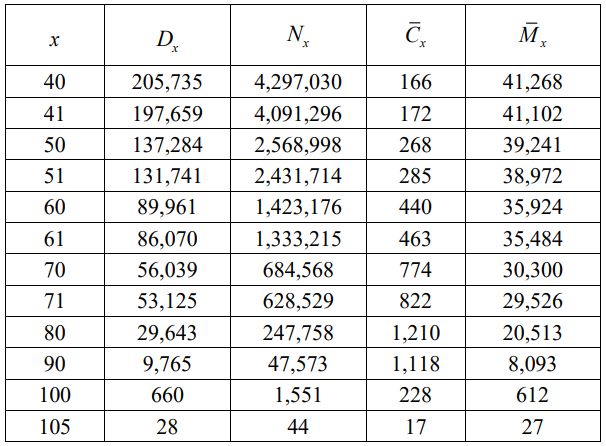

活動名稱
【解題達人! We want you!】
活動說明
阿摩站上可謂臥虎藏龍,阿摩發出200萬顆鑽石號召達人們來解題!
針對一些題目可能有疑問但卻缺少討論,阿摩主動幫大家尋找最佳解!
懸賞試題多達20萬題,快看看是否有自己拿手的科目試題,一旦你的回應被選為最佳解,一題即可獲得10顆鑽石。
懸賞時間結束後,只要摩友觀看你的詳解,每次也會得到10顆鑽石喔!
關於鑽石
如何使用:
- ✔懸賞試題詳解
- ✔購買私人筆記
- ✔購買懸賞詳解
- ✔兌換VIP
(1000顆鑽石可換30天VIP) - ✔兌換現金
(50000顆鑽石可換NT$4,000)
如何獲得:
- ✔解答懸賞題目並被選為最佳解
- ✔撰寫私人筆記販售
- ✔撰寫詳解販售(必須超過10讚)
- ✔直接購買 (至站內商城選購)
** 所有鑽石收入,都會有10%的手續費用
近期考題
【非選題】
四、生產計畫與管制基本上是要將生產活動在時間軸上做最佳的安排,而生產活動的安 排則有賴掌握正確的生產需求,試說明何謂需求預測?(10 分)又有那些方法可以 協助我們掌握正確的需求預測,試舉一例說明之。(10 分)
四、生產計畫與管制基本上是要將生產活動在時間軸上做最佳的安排,而生產活動的安 排則有賴掌握正確的生產需求,試說明何謂需求預測?(10 分)又有那些方法可以 協助我們掌握正確的需求預測,試舉一例說明之。(10 分)
第 37 題~第 44 題使用下表計算:
40. 現年 50 歲購買死亡即刻給付、保額 100 萬之 30 年期生死合險,則躉繳純保費為多少元?
(A) 低於 250,000
(B) 250,001~300,000
(C) 300,001~350,000
(D) 高於 350,001
41. 承第 40 題,若改成二十年繳費,則年繳純保險費為多少元?
(A) 低於 20,000
(B) 20,001~30,000
(C) 30,001~40,000
(D) 高於 40,001
【題組】42. 承第 41 題,若附加費用率為 17%,則年繳總保險費為多少元?
(A) 低於 20,000
(B) 20,001~30,000
(C) 30,001~40,000
(D) 高於 40,001
10. Read the following paragraph that introduces the concept of model predictive control(MPC): Model predic-
tive control (MPC) is an advanced method of process control that is used to control a process while satisfying
a set of constraints. It has been in use in the process industries in chemical plants and oil refneries since
the 1980s. In recent years it has also been used in power system balancing models and in power electronics.
Model predictive controllers rely on dynanic models of the process, most often linear empirical models ob-
tained by system identifcation. The main aduantage of MPC is the fact that it allous the current timeslot to
be optimized, while keeping future timeslots in account. This is achieued by optimizing a finite time-horizon,
but only implementing the current timeslot and then optimizing again, repeatedly, thus differing from Linear-
Quadratic Regulator (LQR). Aiso MPC has the ability to anticipate future events and can take control actions
accordingly. PID controllers do not have this predictive ability. MPC is nearly universally implemented as a
digitaI control, although there is research into achieving jaster response times with specially designed analog
circuitry. (test acquired from Wilipedia)
According to the above paragraph, which of the following statements are true?
(A) MPC applies an optimization solver to acquire the optimal control action with the consideration of the predicted responses and system constraints.
(B) PID controllers do not have the predictive ability because they can be tuned without knowing the dy- namic model.
(C) The performance of MPC may be deteriorated if the dynamic model is inaccurate.
(D) LQR control cannot optimize the control action over a finite time-horizon.
(E) Although it is possible to implement MPC on analog circuitry, MPC is usually implemented on computers or microprocessors.
(A) MPC applies an optimization solver to acquire the optimal control action with the consideration of the predicted responses and system constraints.
(B) PID controllers do not have the predictive ability because they can be tuned without knowing the dy- namic model.
(C) The performance of MPC may be deteriorated if the dynamic model is inaccurate.
(D) LQR control cannot optimize the control action over a finite time-horizon.
(E) Although it is possible to implement MPC on analog circuitry, MPC is usually implemented on computers or microprocessors.